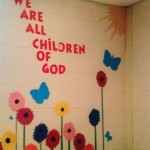Classroom Decoration Ideas for Grade 3: Fostering an Engaging Learning Environment
Creating a stimulating and engaging classroom environment is crucial for Grade 3 students. Well-thought-out decorations can significantly impact a student's learning experience, fostering a sense of belonging, sparking curiosity, and promoting a positive attitude towards education. The aesthetic appeal of a classroom directly influences student motivation and their ability to focus on learning tasks. This article explores several classroom decoration ideas tailored for Grade 3, focusing on strategies to create an inclusive, visually appealing, and educationally enriching space.
Enhancing Learning Through Thematic Decoration
Thematic decoration provides a focused and immersive learning experience. Selecting a specific theme, such as explorers, inventors, or the solar system, provides a framework for decorating the classroom while seamlessly integrating curriculum content. This approach transforms the classroom into a dynamic and interactive learning zone.
Implementing a thematic approach begins with brainstorming appropriate themes that align with the Grade 3 curriculum. For instance, if the curriculum includes a unit on ecosystems, the classroom could be decorated as a rainforest, a coral reef, or a desert environment. Visual aids, such as posters displaying different plant and animal species, can be incorporated. Handmade crafts depicting the ecosystem elements and student research projects displayed on themed bulletin boards reinforce learning.
Selecting colors and materials can further enhance the thematic experience. For a rainforest theme, use shades of green and brown for wall decorations and fabric. Incorporate natural elements, such as branches, leaves (artificial or appropriately sourced), and rocks, to simulate the environment. Soundscapes featuring rainforest sounds played softly in the background can further immerse students in the learning environment.
Rotating themes seasonally or between units keeps the classroom environment fresh and exciting. This prevents the space from becoming monotonous and encourages student engagement with new topics. The transition between themes also provides an opportunity to involve students in the decoration process, fostering collaboration and ownership of their learning environment.
Furthermore, consider integrating interactive elements within the thematic decorations. For example, a world map can be incorporated into an explorer theme, allowing students to track the routes of famous explorers or identify different countries. A timeline of significant inventions can be displayed as part of an inventors theme, with interactive elements such as QR codes linking to online resources or videos. These interactive elements reinforce learning and cater to various learning styles.
Remember that thematic decorations should be age-appropriate and avoid overwhelming the learning space. Overly cluttered or distracting decorations can hinder learning rather than enhance it. Maintaining a balance between visual appeal and functionality is essential. Ensure that decorations are easily accessible and do not obstruct pathways or block access to learning materials.
Promoting Literacy and Numeracy Through Visual Displays
Decorations can be directly integrated to reinforce literacy and numeracy skills. Visual displays that incorporate key vocabulary, mathematical concepts, and grammar rules provide constant learning opportunities for Grade 3 students. These displays act as visual reminders, supporting students as they develop essential skills.
Creating a word wall is a fundamental technique for promoting literacy. The word wall should feature high-frequency words, vocabulary words related to current reading materials, and words that students commonly misspell. Arrange words alphabetically or categorize them by theme or part of speech. Use large, readable fonts and clear visuals to aid comprehension.
Incorporate grammar rules into visually appealing posters. For instance, a poster explaining the difference between nouns, verbs, and adjectives can be displayed prominently in the classroom. Use examples and illustrations to clarify the rules and make them memorable. Create interactive charts where students can add their own examples or correct errors.
Numeracy skills can be reinforced through displays featuring number lines, multiplication tables, and geometric shapes. A number line spanning the length of the classroom can be used for various mathematical activities, such as counting, adding, and subtracting. Multiplication tables presented in a visually appealing format can aid memorization. Geometric shapes displayed with their properties can reinforce spatial reasoning skills.
Consider creating interactive math games and activities that are integrated into the classroom decorations. For example, a bulletin board displaying different fractions can be accompanied by a matching game where students match the fraction to its visual representation. These interactive elements make learning engaging and reinforce concepts in a practical manner.
When creating literacy and numeracy displays, ensure they are age-appropriate and aligned with the Grade 3 curriculum. Avoid overwhelming students with too much information. Prioritize clarity and simplicity to maximize their learning potential. Update the displays regularly to reflect new learning goals and maintain student interest.
Furthermore, involve students in creating and maintaining literacy and numeracy displays. This fosters ownership and reinforces their learning. Encourage students to contribute examples, create illustrations, or design interactive elements. This collaborative approach enhances their understanding and fosters a sense of community within the classroom.
Creating a Positive and Inclusive Classroom Atmosphere
Classroom decorations can contribute significantly to establishing a positive and inclusive atmosphere. Displaying student work, showcasing diverse cultures, and promoting positive affirmations creates a welcoming and supportive learning environment where all students feel valued and respected. A positive classroom atmosphere fosters a sense of belonging, promotes collaboration, and encourages students to take risks in their learning.
Showcasing student work is a powerful way to build confidence and celebrate achievements. Displaying artwork, writing samples, and project reports demonstrates that student efforts are valued and appreciated. Rotate the displayed work regularly to ensure that all students have the opportunity to have their work featured. Provide constructive feedback on student work and encourage peer feedback to promote growth and learning.
Incorporate decorations that celebrate diversity and inclusivity. Display posters featuring individuals from various cultures and backgrounds who have made significant contributions in different fields. Include books and resources that reflect diverse perspectives and experiences. Celebrate cultural holidays and events throughout the year to promote understanding and appreciation of different cultures.
Promote positive affirmations and growth mindset through visual displays. Display posters featuring positive messages such as "I can do it," "Mistakes are opportunities to learn," and "I am capable." These affirmations can help students develop a positive self-image and build resilience. Create a "growth mindset" bulletin board where students can share examples of how they have overcome challenges and learned from their mistakes.
Consider creating a "kindness corner" in the classroom, where students can write thank you notes or express appreciation for their classmates. This promotes empathy and fosters a culture of kindness and respect. Display student-created artwork or posters that promote positive relationships and conflict resolution.
Involving students in creating decorations that promote a positive and inclusive atmosphere fosters a sense of ownership and responsibility. Encourage students to design posters, write affirmations, or create artwork that reflects their values and beliefs. This collaborative approach promotes a sense of community and reinforces the importance of inclusivity.
Remember that creating a positive and inclusive classroom atmosphere is an ongoing process. Regularly assess the classroom environment and make adjustments as needed to ensure that all students feel valued, respected, and supported. Foster open communication and encourage students to share their thoughts and feelings. By creating a welcoming and supportive learning environment, educators can empower students to thrive academically, socially, and emotionally.

Classroom Decor 3rd Grade Third Math

20 Best Classroom Decoration Ideas For Teachers

Awesome Classroom Decoràtion Ideas For Grade 3

Mr H S Grade 3 4 Classroom Displays

Classroom Decorations School Specialty

17 Inspirational Third Grade Classroom Ideas We Are Teachers

Classroom Decorations School Specialty

Classroom Decor Ideas Elementary Tropical Theme

60 Gorgeous Classroom Design Ideas For Back To School Matchness Com Diy Decorations Library

Classroom Decorations School Specialty
Related Posts







